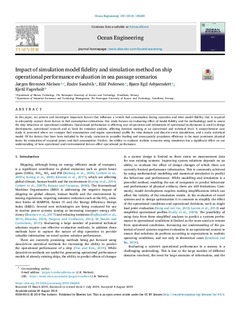| dc.contributor.author | Nielsen, Jørgen Bremnes | |
| dc.contributor.author | Sandvik, Endre | |
| dc.contributor.author | Pedersen, Eilif | |
| dc.contributor.author | Asbjørnslett, Bjørn Egil | |
| dc.contributor.author | Fagerholt, Kjetil | |
| dc.date.accessioned | 2019-12-05T07:57:01Z | |
| dc.date.available | 2019-12-05T07:57:01Z | |
| dc.date.created | 2019-08-05T11:13:08Z | |
| dc.date.issued | 2019 | |
| dc.identifier.citation | Ocean Engineering. 2019, 188 . | nb_NO |
| dc.identifier.issn | 0029-8018 | |
| dc.identifier.uri | http://hdl.handle.net/11250/2631846 | |
| dc.description.abstract | In this paper, we present and investigate important factors that influence a vessels fuel consumption during operation and what model fidelity that is required to adequately capture these factors in fuel consumption estimations. Our study focuses on evaluating effect of model fidelity and the methodology used to assess the ship behaviour in operational conditions. Operational performance is affecting cost of operation and estimations of operational performance is used in design development, operational research and as basis for emission analysis, affecting decision making at an operational and technical level. A comprehensive case study is presented where we compare fuel consumption and engine operational profile for time domain and discrete-event simulations, and a static statistical model. Of the factors that have been included in the study, variation in propeller loading and consequently propulsion efficiency is the most prominent physical factor for estimation of required power and fuel consumption. Further, the ability to replicate realistic scenarios using simulators has a significant effect on our understanding of how operational and environmental factors affect operational performance. | nb_NO |
| dc.language.iso | eng | nb_NO |
| dc.publisher | Elsevier | nb_NO |
| dc.rights | Navngivelse 4.0 Internasjonal | * |
| dc.rights.uri | http://creativecommons.org/licenses/by/4.0/deed.no | * |
| dc.title | Impact of simulation model fidelity and simulation method on ship operational performance evaluation in sea passage scenarios | nb_NO |
| dc.type | Journal article | nb_NO |
| dc.type | Peer reviewed | nb_NO |
| dc.description.version | publishedVersion | nb_NO |
| dc.source.pagenumber | 18 | nb_NO |
| dc.source.volume | 188 | nb_NO |
| dc.source.journal | Ocean Engineering | nb_NO |
| dc.identifier.doi | 10.1016/j.oceaneng.2019.106268 | |
| dc.identifier.cristin | 1714006 | |
| dc.description.localcode | This is an open access article distributed under the terms of the Creative Commons CC-BY license, which permits unrestricted use, distribution, and reproduction in any medium, provided the original work is properly cited. You are not required to obtain permission to reuse this article. | nb_NO |
| cristin.unitcode | 194,64,20,0 | |
| cristin.unitcode | 194,60,25,0 | |
| cristin.unitname | Institutt for marin teknikk | |
| cristin.unitname | Institutt for industriell økonomi og teknologiledelse | |
| cristin.ispublished | true | |
| cristin.fulltext | preprint | |
| cristin.qualitycode | 1 | |

